
Japetus Steenstrup
Encyclopedia

Denmark
Denmark is a Scandinavian country in Northern Europe. The countries of Denmark and Greenland, as well as the Faroe Islands, constitute the Kingdom of Denmark . It is the southernmost of the Nordic countries, southwest of Sweden and south of Norway, and bordered to the south by Germany. Denmark...
zoologist, biologist
Biologist
A biologist is a scientist devoted to and producing results in biology through the study of life. Typically biologists study organisms and their relationship to their environment. Biologists involved in basic research attempt to discover underlying mechanisms that govern how organisms work...
, and professor
Professor
A professor is a scholarly teacher; the precise meaning of the term varies by country. Literally, professor derives from Latin as a "person who professes" being usually an expert in arts or sciences; a teacher of high rank...
.
He was a professor of zoology
Zoology
Zoology |zoölogy]]), is the branch of biology that relates to the animal kingdom, including the structure, embryology, evolution, classification, habits, and distribution of all animals, both living and extinct...
at the University of Copenhagen
University of Copenhagen
The University of Copenhagen is the oldest and largest university and research institution in Denmark. Founded in 1479, it has more than 37,000 students, the majority of whom are female , and more than 7,000 employees. The university has several campuses located in and around Copenhagen, with the...
. He worked on a great many of subjects, including cephalopod
Cephalopod
A cephalopod is any member of the molluscan class Cephalopoda . These exclusively marine animals are characterized by bilateral body symmetry, a prominent head, and a set of arms or tentacles modified from the primitive molluscan foot...
s, but also in genetics
Genetics
Genetics , a discipline of biology, is the science of genes, heredity, and variation in living organisms....
, where he discovered the principle of the alternation of generations
Alternation of generations
Alternation of generations is a term primarily used in describing the life cycle of plants . A multicellular sporophyte, which is diploid with 2N paired chromosomes , alternates with a multicellular gametophyte, which is haploid with N unpaired chromosomes...
in some parasitic worms in 1842.
Steenstrup discovered (1842) the possibility of using the subfossils of the Postglacial
Holocene
The Holocene is a geological epoch which began at the end of the Pleistocene and continues to the present. The Holocene is part of the Quaternary period. Its name comes from the Greek words and , meaning "entirely recent"...
as a means of interpreting climate change
Climate change
Climate change is a significant and lasting change in the statistical distribution of weather patterns over periods ranging from decades to millions of years. It may be a change in average weather conditions or the distribution of events around that average...
s and correlated vegetation
Vegetation
Vegetation is a general term for the plant life of a region; it refers to the ground cover provided by plants. It is a general term, without specific reference to particular taxa, life forms, structure, spatial extent, or any other specific botanical or geographic characteristics. It is broader...
change, which he called succession
Ecological succession
Ecological succession, is the phenomenon or process by which a community progressively transforms itself until a stable community is formed. It is a fundamental concept in ecology, and refers to more or less predictable and orderly changes in the composition or structure of an ecological community...
in the recent past. Two of Steenstrup's students, Christian Vaupell
Christian Vaupell
Christian Theodor Vaupell was a Danish botanist and forester. He was a student of Japetus Steenstrup and a teacher of botany at the University of Copenhagen to the young Eugen Warming....
and Eugen Warming further developed this line of research.
Japetus Steenstrup was a professor to zoologist Johan Erik Vesti Boas
Johan Erik Vesti Boas
Johan Erik Vesti Boas , also J.E.V. Boas, was a Danish zoologist and a disciple of Carl Gegenbaur and Steenstrup. During the beginning and end of his career, Johan Erik Vesti Boas worked at the Zoological Museum of Copenhagen...
, who was also a student of zoologist Carl Gegenbaur, and Hans Christian Gram
Hans Christian Gram
Hans Christian Joachim Gram was a Danish bacteriologist.He was the son of Frederik Terkel Julius Gram, a professor of jurisprudence, and Louise Christiane Roulund....
, inventor of the Gram stain.
Together with Johan Lange, Steenstrup was the publisher of Flora Danica
Flora Danica
A product of The Age of Enlightenment, Flora Danica is a comprehensive atlas of botany, containing folio-sized pictures of all the wild plants native to Denmark, in the period from 1761-1883....
fasc. 44.
In 1857, he was elected a foreign member of the Royal Swedish Academy of Sciences
Royal Swedish Academy of Sciences
The Royal Swedish Academy of Sciences or Kungliga Vetenskapsakademien is one of the Royal Academies of Sweden. The Academy is an independent, non-governmental scientific organization which acts to promote the sciences, primarily the natural sciences and mathematics.The Academy was founded on 2...
.


